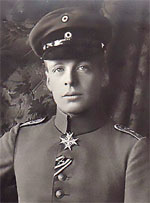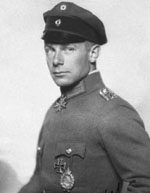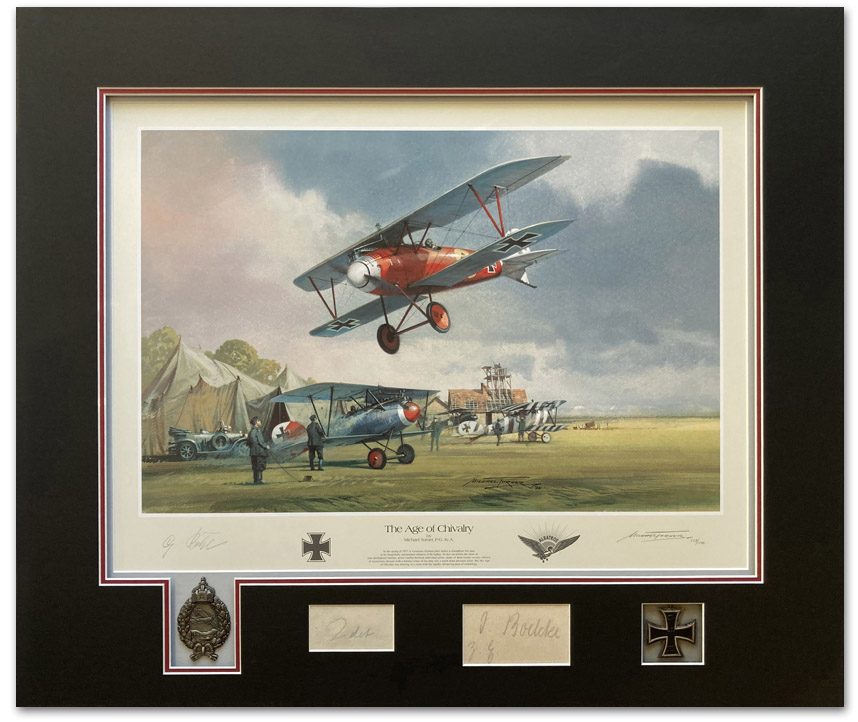

The Age of Chivalry
by Michael Turner
| Oswald Boelcke & Ernst Udet |
Michael Turner's beautiful portrayal of the Albatros DIII, signed by WWI Albatros pilot and squadron commander Gustav Boehl, is presented here conservation mounted with the signatures of two outstanding Aces of World War One - Oswald Boelcke and Ernst Udet. |
| Overall size: 23½" x 27¾" |
| Museum Presentation | With original Oswald Boelcke & Ernst Udet signatures and original WWI Iron Cross |
| SOLD |
|
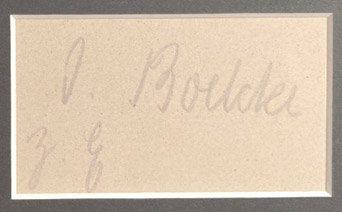 matted signature - see note below |
Boelcke fulfilled his childhood dream of a military career by joining the Imperial German Army on 15 March 1911. He pursued an early interest in aviation, learning to fly as World War I began. After duty as an aerial observer during 1914, in mid 1915 he became one of the first of a new type of warrior- a fighter pilot. Flying the first true fighters, Boelcke, Max Immelmann, and several other early aces began racking up aerial victories against enemy aircraft. Boelcke and Immelmann were the first German fighter pilots awarded Prussia's highest honor, the Pour le Mérite. After a mandated holiday leave spent on a military inspection tour of Ottoman facilities, Boelcke was picked to lead one of Germany's first fighter squadrons, Jagdstaffel 2 . Its pilots were hand-picked by Boelcke and indoctrinated in his Dicta through extensive training. During September and October 1916, Boelcke scored 21 more victories while commanding Jagdstaffel 2, maintaining his position as the world's highest-scoring ace. He was killed in a mid-air collision with his best friend, Erwin Böhme, on 28 October 1916. By the end of the war, Jagdstaffel 2 (renamed Jasta Boelcke) had 25 aces in its ranks; many of them were selected to lead other squadrons and four of its members became generals during World War II. Boelcke's influence extends to the present, with extensive tributes to him at Air Force's bases throughout Germany. |
|
| The initials Z. E. below Boelcke's signature stand for Zur Erinnerung, meaning "as a reminder" in this context it intends the signature to be a memento or souvenir. | |
|
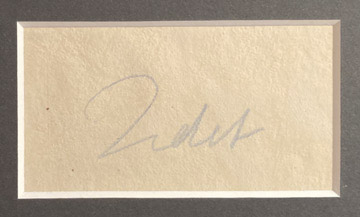 matted signature |
Later, Udet was court-martialed for losing an aircraft in an incident the flying corps considered a result of bad judgement. Overloaded with fuel and bombs, the aircraft stalled after a sharp bank and plunged to the ground. Miraculously, both Udet and Justinius survived with only minor injuries. Udet was placed under arrest in the guardhouse for seven days. Udet was assigned a new Fokker to fly to his new fighter unit - FFA 68 - at Habsheim. Mechanically defective, the plane crashed into a hangar when he took off, so he was then given an older Fokker to fly. In this aircraft, he experienced his first aerial combat, which almost ended in disaster. While lining up on a French Caudron, Udet found he could not bring himself to fire on another person and was subsequently fired on by the Frenchman. A bullet grazed his cheek and smashed his flying goggles. Udet survived the encounter, but from then on learned to attack aggressively and began scoring victories, downing his first French opponent on 18 March 1916. That year, FFA 68 was renamed Kampfeinsitzer Kommando Habsheim before becoming Jagdstaffel 15. In January 1917 Jasta 15 By this time Udet had become a triple ace, his success attracted attention earning him an invitation to join the "Flying Circus", Jagdgeschwader 1 under the command of Manfred von Richthofen. After watching Udet shoot down an artillery spotter by frontal attack, Richthofen gave him command of Jasta 11, von Richthofen's former squadron command. Udet scored 20 victories in August 1918 alone, mainly against British aircraft and became a national hero with 62 confirmed victories to his credit by the end of the war. |
|
Gustav Boehl As the war drew on Boehl eventually managed to obtain a place in pilot training and graduated |
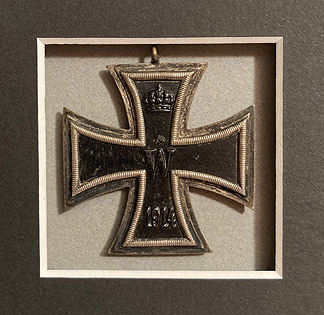 |
| Original WWI Iron Cross included in the mount |
